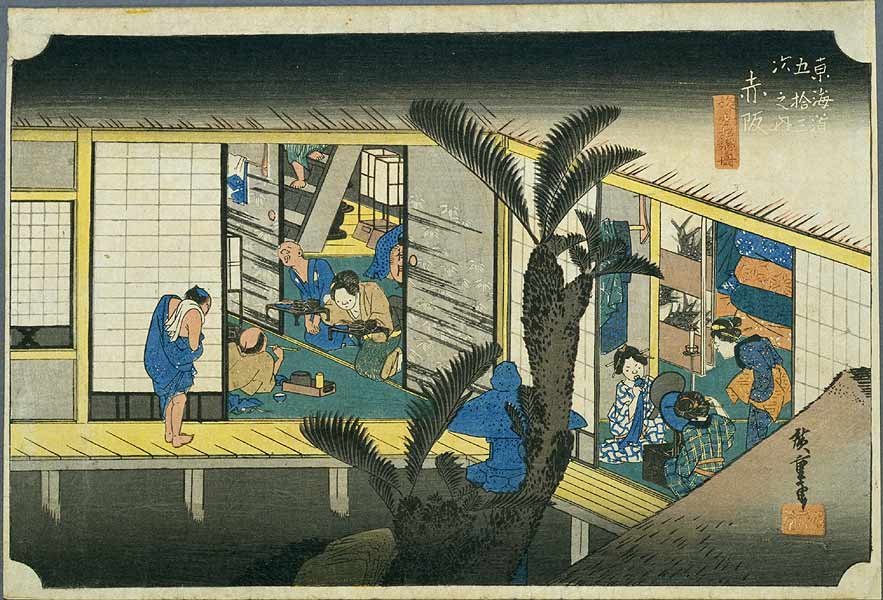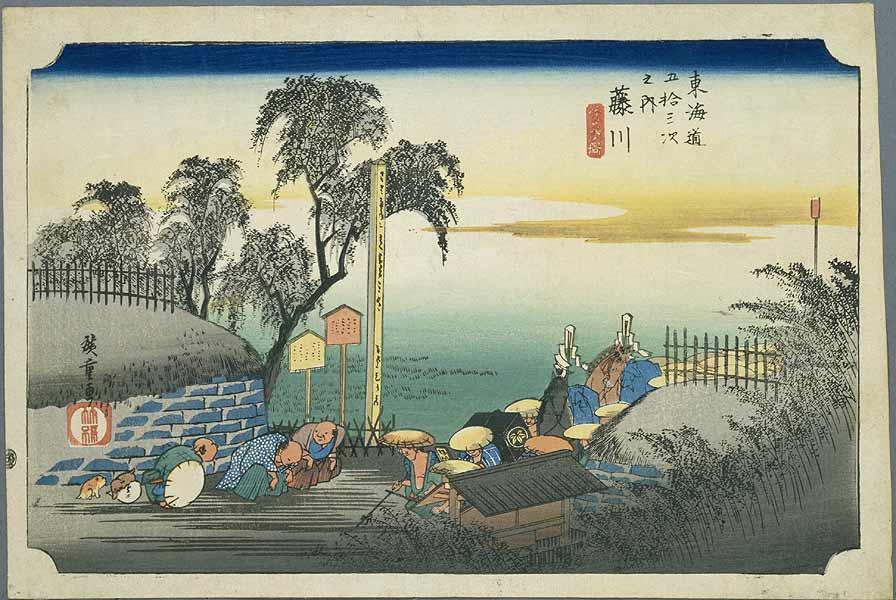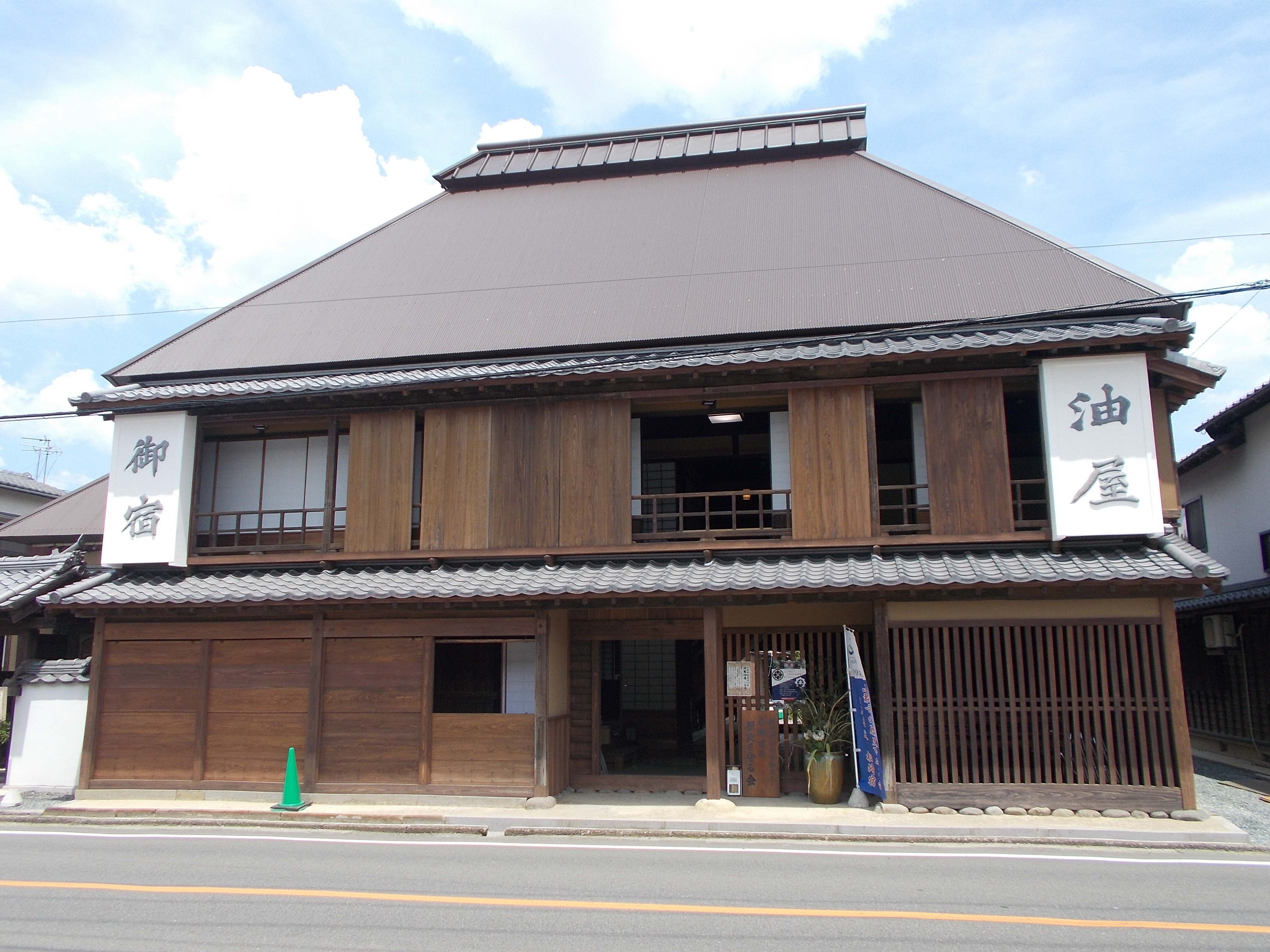|
Akasaka-juku (Tōkaidō)
was the thirty-sixth of the fifty-three stations of the Tōkaidō. It is located in present-day Toyokawa, Aichi Prefecture, Japan. It was only from Goyu-juku, the preceding post station. History Along with the preceding Yoshida-juku and Goyu-shuku, Akasaka-juku was well known for its '' meshimori onna''. The classic ukiyo-e print by Andō Hiroshige (''Hoeido'' edition) from 1831–1834 depicts a typical inn; the scene is divided in half by a sago palm in the center. To the right, travellers are taking their evening meal, and to the left, prostitutes are putting on make-up and preparing for the evening entertainment. Due to its reputation, Akasaka was a popular post station with many travellers. Ōhashi-ya (大橋屋), an inn that first opened in 1649, less than half a century after the creation of the Tōkaidō, still operates today. The building it uses was built in 1716. During a census in 1733, there were 83 inns in Akasaka-juku, but only Ōhashi-ya remains today. ... [...More Info...] [...Related Items...] OR: [Wikipedia] [Google] [Baidu] |
Nakasendō
The , also called the ,Richard Lane, ''Images from the Floating World'' (1978) Chartwell, Secaucus ; pg. 285 was one of the five routes of the Edo period, and one of the two that connected Edo (modern-day Tokyo) to Kyoto in Japan. There were 69 stations (staging-posts) between Edo and Kyoto, crossing through Musashi, Kōzuke, Shinano, Mino and Ōmi provinces.Nakasendou Jouhou . NEC Corporation. Retrieved August 18, 2007. In addition to Tokyo and Kyoto, the Nakasendō runs through the modern-day prefectures of Saitama, , |
Andō Hiroshige
Utagawa Hiroshige (, also ; ja, 歌川 広重 ), born Andō Tokutarō (; 1797 – 12 October 1858), was a Japanese ''ukiyo-e'' artist, considered the last great master of that tradition. Hiroshige is best known for his horizontal-format landscape series ''The Fifty-three Stations of the Tōkaidō'' and for his vertical-format landscape series ''One Hundred Famous Views of Edo''. The subjects of his work were atypical of the ''ukiyo-e'' genre, whose typical focus was on beautiful women, popular actors, and other scenes of the urban pleasure districts of Japan's Edo period (1603–1868). The popular series '' Thirty-six Views of Mount Fuji'' by Hokusai was a strong influence on Hiroshige's choice of subject, though Hiroshige's approach was more poetic and ambient than Hokusai's bolder, more formal prints. Subtle use of color was essential in Hiroshige's prints, often printed with multiple impressions in the same area and with extensive use of '' bokashi'' (color gradation), ... [...More Info...] [...Related Items...] OR: [Wikipedia] [Google] [Baidu] |
Fujikawa-shuku
was the thirty-seventh of the fifty-three stations of the Tōkaidō. It is located in the present-day city of Okazaki, in Aichi Prefecture, Japan. It was approximately from Akasaka-juku, the preceding post station.Tokaido 53: Fujikawa-juku (Okazaki) . Tōkaidō no Tabi. Accessed March 6, 2008. Another accepted reading for this post town is "Fujikawa-juku." At its peak, Fujikawa-juku was home to 302 buildings, including one '' honjin'', one sub-''honjin'' and 36 '' hatago''. Its total population was approximately 1,200 people. The classic |
Meiden-Akasaka Station
Platforms is a railway station in the city of Toyokawa, Aichi, Japan, operated by Meitetsu. Lines Meiden Akasaka Station is served by the Meitetsu Nagoya Main Line and is 12.5 kilometers from the terminus of the line at Toyohashi Station. Station layout The station has two elevated opposed side platforms with the station building underneath. The station has automated ticket machines, Manaca automated turnstiles and is unattended. Platforms Adjacent stations Station history Meiden Akasaka Station was opened on 1 April 1926 as on the Aichi Electric Railway. On 1 April 1935, the Aichi Electric Railway merged with the Nagoya Railroad (the forerunner of present-day Meitetsu). The station was renamed to its present name on 1 December 1938. The station has been unattended since 1971. Passenger statistics In fiscal 2017, the station was used by an average of 517 passengers daily. Surrounding area *former Otowa Town Hall * Akasaka-juku (Tōkaidō) See also * List of Railw ... [...More Info...] [...Related Items...] OR: [Wikipedia] [Google] [Baidu] |
Meitetsu Nagoya Main Line
{{BS-map , title=Nagoya Main Line , title-bg=red , top= *Subway: Nagoya Municipal Subway *Lines are Meitetsu unless otherwise noted , collapse=yes , map= {{BS, STR, , , Tokaido Main Line} {{BS3, , STR, hSTR, , , Tokaido Shinkansen} {{BS5, STR+l, STRq, KRZu, hKRZ, , , , Toyohashi Railway Atsumi Line} {{BS7, KRW+l, xKRWgr, , STR, hSTR, , , , , } {{BS7, KBHFe, exSTR, , STR, hSTR, , , , , {{STN, Shin-Toyohashi} {{BS7, uSTR+r, exKBHFe, , STR, hSTRe, , , , , Toyohashi Railway Azumada Main Line} {{BS7, uKBHFxe, KBHFa, O2=HUBaq, KBHFa, O3=HUBq, BHF, O4=HUBq, BHF, O5=HUBeq, , , 0.0, {{STN, Toyohashi, } {{BS7, uexLSTR, STR, O2=SHI3l, SHI1l, O3=vSHI3+r-, STR, hSTRa, , , , , } {{BS7, uexKBHFe, STR, vSTR, O3=v-SHI3+l, STR, O4=SHI3r, hSTR, , , , , Shimin-Byōin-mae} {{BS5, KBSTe, vÜST, STR, hSTR, , , , Toyohashi depot} {{BS5, exSHI3+l, exvSHI3r-, O2=vSTR, STR, hSTR, , , , JR-C: Tōkaidō Shinkansen} {{BS5, exSTR, vSTR, STR, hSTRl, , , , JR-F: Toyohashi ORS} {{BS5, exKDSTe, vBHF, KRWl ... [...More Info...] [...Related Items...] OR: [Wikipedia] [Google] [Baidu] |
Tōkaidō Main Line
The is a major Japanese railway line of the Japan Railways Group (JR Group) network, connecting and stations. It is long, not counting its many freight feeder lines around the major cities. The high-speed Tōkaidō Shinkansen largely parallels the line. The term "Tōkaidō Main Line" is largely a holdover from pre-Shinkansen days; now various portions of the line have different names which are officially used by JR East, JR Central, and JR West. Today, the only daily passenger train that operate over the entire length of the line is the combined overnight-train Sunrise Izumo - Sunrise Seto. During the day longer intercity trips require several transfers along the way. The Tokaido Main Line is owned and operated by three JR companies: * East Japan Railway Company (JR East) ( - ) Tōkaidō Line * Central Japan Railway Company (JR Central) ( - ) Tōkaidō Line * West Japan Railway Company (JR West) ( - ) Biwako Line, JR Kyoto Line, JR Kobe Line Basic data *Total distance: (i ... [...More Info...] [...Related Items...] OR: [Wikipedia] [Google] [Baidu] |
Haiku
is a type of short form poetry originally from Japan. Traditional Japanese haiku consist of three phrases that contain a ''kireji'', or "cutting word", 17 '' on'' (phonetic units similar to syllables) in a 5, 7, 5 pattern, and a ''kigo'', or seasonal reference. Similar poems that do not adhere to these rules are generally classified as ''senryū''. Haiku originated as an opening part of a larger Japanese poem called renga. These haiku written as an opening stanza were known as ''hokku'' and over time they began to be written as stand-alone poems. Haiku was given its current name by the Japanese writer Masaoka Shiki at the end of the 19th century. Originally from Japan, haiku today are written by authors worldwide. Haiku in English and haiku in other languages have different styles and traditions while still incorporating aspects of the traditional haiku form. Non-Japanese haiku vary widely on how closely they follow traditional elements. Additionally, a minority movement withi ... [...More Info...] [...Related Items...] OR: [Wikipedia] [Google] [Baidu] |
Matsuo Bashō
born then was the most famous poet of the Edo period in Japan. During his lifetime, Bashō was recognized for his works in the collaborative '' haikai no renga'' form; today, after centuries of commentary, he is recognized as the greatest master of haiku (then called hokku). He is also well known for his travel essays beginning with '' Records of a Weather-Exposed Skeleton'' (1684), written after his journey west to Kyoto and Nara. Matsuo Bashō's poetry is internationally renowned, and, in Japan, many of his poems are reproduced on monuments and traditional sites. Although Bashō is famous in the West for his hokku, he himself believed his best work lay in leading and participating in renku. He is quoted as saying, "Many of my followers can write hokku as well as I can. Where I show who I really am is in linking haikai verses." Bashō was introduced to poetry at a young age, and after integrating himself into the intellectual scene of Edo (modern Tokyo) he quickly became we ... [...More Info...] [...Related Items...] OR: [Wikipedia] [Google] [Baidu] |
Hatago
were Edo period lodgings for travelers at '' shukuba'' (post stations) along the national highways, including the Edo Five Routes The , sometimes translated as "Five Highways", were the five centrally administered routes, or ''kaidō'', that connected the ''de facto'' capital of Japan at Edo (now Tokyo) with the outer provinces during the Edo period (1603–1868). The most ... and the subroutes. In addition to a place to rest, ''hatago'' also offered meals and other foods to the travelers. They were also called . Name origin ''Hatago'' means "traveling basket." The word itself originally derived from baskets that contained food for horses and were carried by travelers. From there, it became a tool with which travelers were carry their own food and goods. Shops that began preparing and selling food for travelers gained the suffix , meaning "shop," but this was eventually shortened to just ''hatago''. Preserved ''hatago'' Because many post stations along the Tōkaidō, Nakas ... [...More Info...] [...Related Items...] OR: [Wikipedia] [Google] [Baidu] |
Honjin
The ''honjin'' at Inaba Kaidō's Ōhara-shuku.">Ōhara-shuku.html" ;"title="Inaba Kaidō's Ōhara-shuku">Inaba Kaidō's Ōhara-shuku. is the Japanese word for an inn for government officials, generally located in post stations (''shukuba'') during the later part of the Edo period. Evolution of ''Honjin'' Originally, ''honjin'' were places from which generals directed battles and, therefore, were fleeting in nature. However, as commanders began to transform the ''honjin'' into temporary lodgings during battle and travel, ''honjin'' came to be places where ''daimyō'' and other representatives of the shogunate, including ''hatamoto'', ''monzeki'', etc., were allowed to stay during their travels. Many of the ''honjin'' were actually personal residences of village and town leaders. As such, they received official designations from the government and expanded their residences to include walls, gates and other features. Because of their cooperation, the owners of the ''honjin'' also ... [...More Info...] [...Related Items...] OR: [Wikipedia] [Google] [Baidu] |
Cycas Revoluta
''Cycas revoluta'' (Sotetsu apanese ソテツ sago palm, king sago, sago cycad, Japanese sago palm) is a species of gymnosperm in the family Cycadaceae, native to southern Japan including the Ryukyu Islands. It is one of several species used for the production of sago, as well as an ornamental plant. The sago cycad can be distinguished by a thick coat of fibers on its trunk. The sago cycad is sometimes mistakenly thought to be a palm, although the only similarity between the two is that they look similar and both produce seeds. The leaves grow from the trunk and start out as small leaves near the centre of the plant. Names Cycads' only relations to the true palms (Arecaceae) is that both are vascular plants and seed plants. The Latin specific epithet ''revoluta'' means "curled back", in reference to the leaves. This is also called kungi (comb) palm in Urdu speaking areas. Description This very symmetrical plant supports a crown of shiny, dark green leaves on a thick shaggy t ... [...More Info...] [...Related Items...] OR: [Wikipedia] [Google] [Baidu] |


_Awa_Naruto_no_fuukei.jpg)







